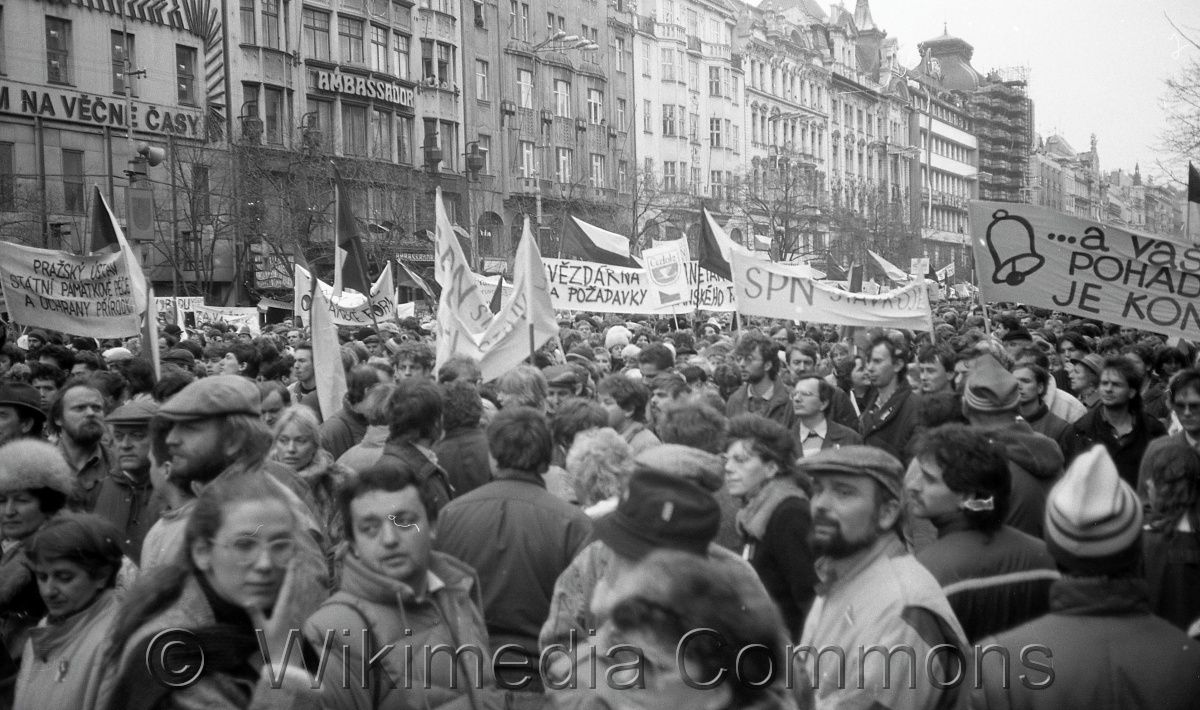The 1948 Czechoslovak coup d'état – National Security Corps in Prague
By seizing the power on 25 February 1948, the communists buried Czechoslovak parliamentary democracy for more than 40 years. This event was greatly facilitated by Sbor národní bezpečnosti (SNB) [National Security Corps] after calling the “Alfa Praha” and “Beta Praha” code-words by the interior minister V. Nosek. Selected formations moved to the capital and took control of the government building and seats of the main opponents. From 22 February, the SNB reinforced patrols that had already “protected” all Prague bridges, railway stations, post offices, the radio, telephone exchange, and other important objects.
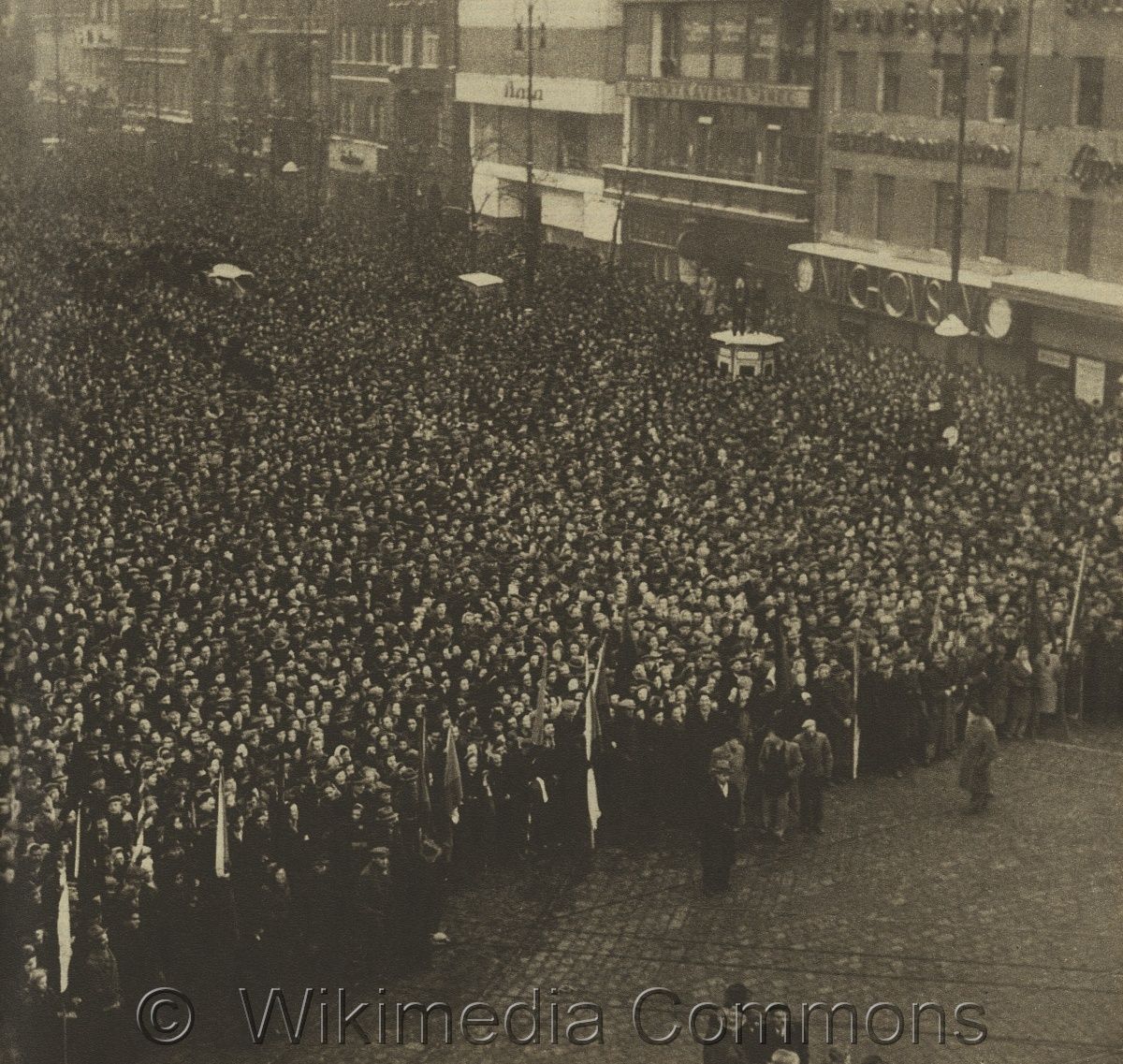
Crowd of people in Wenceslas Square on 25 February 1948. Wikimedia Commons. Accessible here.
References
Kroupa, V.: Sbor národní bezpečnosti 1945–1948. Praha 1977;
Kaplan, K.: Pět kapitol o únoru. Brno 1997;
Semotanová, E. ‒ Zudová-Lešková, Z. – Močičková, J. – Cajthaml, J. – Seemann, P. – Bláha, J., D. a kol.: Český historický atlas. Kapitoly z dějin 20. století. Praha 2019.

This work is licensed under a Creative Commons BY-NC-ND 4.0
Invasion of Czechoslovakia by the Occupying Armies in August 1968
The invasion of Czechoslovakia from four directions by five armies of the Warsaw Pact communist countries on 21 August 1968 at the request of the conservative wing of the Communist Party of Czechoslovakia (KSČ) involved 27 infantry and air divisions. 800 aircraft, more than 6,000 tanks and 600,000 soldiers were gradually deployed. The invasion was opposed to not only Czechoslovak public, government and many politicians, but it was also condemned in the international field. According to a treaty of 16 October 1968 on the “temporary” stay of the troops, the Soviet units stayed in the country until June 1991.
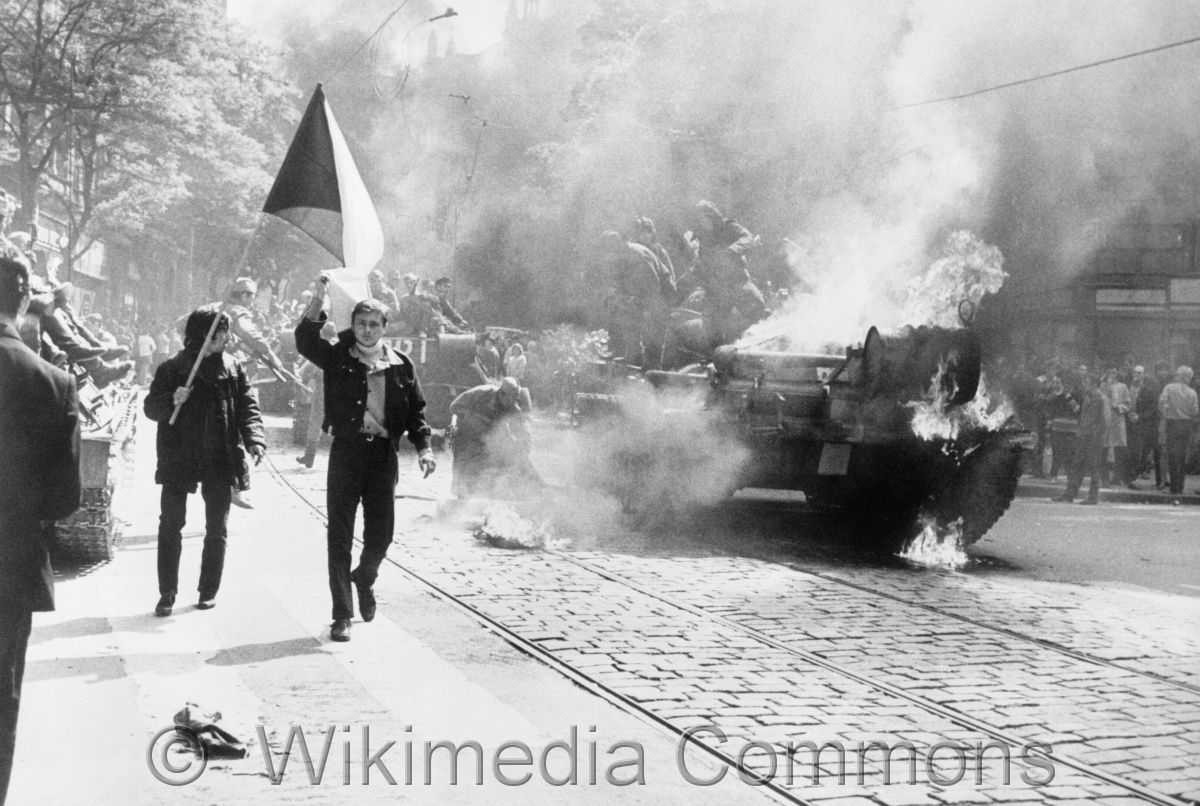
A burning Soviet tank in the streets of Prague. Wikimedia Commons. Accessible here.

Arrival of the occupiers in Náchod, East Bohemia, August 21, 1968. Photo Collection, Náchod State District Archive, 1968.
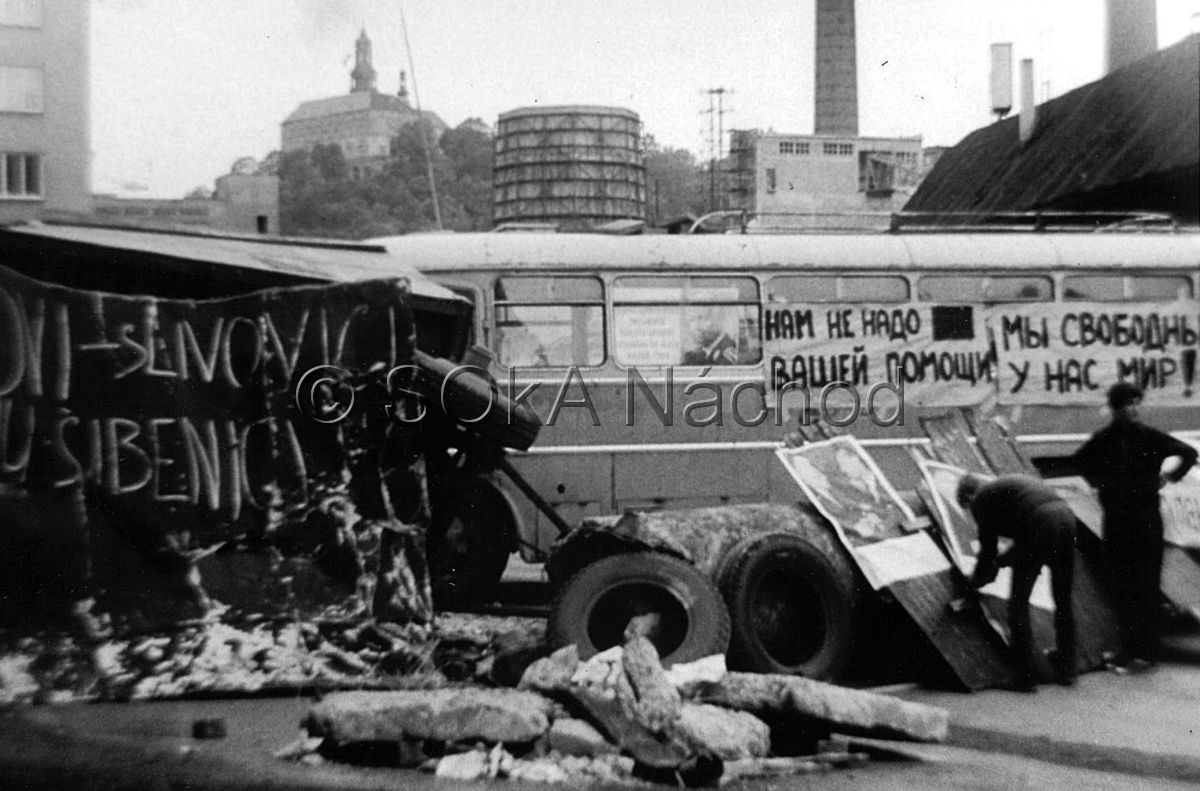
Barricade welcoming the occupiers in Náchod, East Bohemia, August 21, 1968. Photo Collection, Náchod State District Archive, 1968.
References
Valenta, J.: Sovětská intervence v Československu 1968. Anatomie rozhodnutí. Praha 1991. ;
Povolný, D.: Operace Dunaj. Praha 2018. ;
Semotanová, E. ‒ Zudová-Lešková, Z. – Močičková, J. – Cajthaml, J. – Seemann, P. – Bláha, J., D. a kol.: Český historický atlas. Kapitoly z dějin 20. století. Praha 2019.

This work is licensed under a Creative Commons BY-NC-ND 4.0
Beginning of Resistance against the Communist Regime (Prague)
In the second half of the 1960s, the resistance against the regime was growing, especially in politics, economy, culture and civil life. The revivalistic process in the society was violently broken by the Soviet Union, which regarded it as a counter-revolution and attack against socialism and communism. On 21 August 1968, the armies of the Soviet Union, the German Democratic Republic, Poland, Hungary, and Bulgaria invaded Czechoslovakia, thus terminating all efforts to democratise society. The Soviet units were deployed in the country to protect the socialist establishment and remained there until 1991. These events prompted mass cleansing in various areas of society and started the process of normalisation to preserve the communist regime. There were many protests against the occupation. The unforgettable moments that still remind us of the tragic events include the so-called “Human Torches”. Ryszard Siwiec, Jan Palach, Jan Zajíc, Josef Hlavatý, and Evžen Plocek burned themselves to death in protest against the occupation, scarifying their lives to the ideas of democracy and freedom.
Opponents of the ruling regime gradually emerged. In 1977, they issued a statement called “Charter 77”, in which they demanded changes in the society in favour of democracy and respect for human rights. However, they faced severe repressions. The resistance against the regime culminated on 17 November 1989 with a student demonstration in Prague terminated by police intervention in Národní třída. The peaceful student manifestation was severely suppressed by the police forces and became a catalyst for the “Velvet Revolution” when the existing political and social structures rapidly collapsed within several days. The political movement Občanské hnutí [Civic Forum] was established in the Činoherní klub theatre in Prague, uniting not only groups of dissidents but all citizens who disapproved of the existing regime. Václav Havel became the leading figure and in Slovakia, where a similar civic movement Verejnosť proti násiliu [Public against Violence] was established, Ján Budaj and Milan Kňažko became the leaders. The communist regime fell and the process of returning Czechoslovakia to the democratic European states began. The Czechoslovak political system, but also the economy and the entire structure of the society started to transform in the spirit of liberal principles. The new values, self-realization, free will, but also the emerging negative aspects of the development affected the behaviour and thinking of many groups of the population. On 1 January 1993, three years of democratic Czechoslovakia were terminated by its separation into two sovereign equal states, the Czech Republic and the Slovak Republic.

Velvet Revolution, 1 December 1989. Wikimedia Commons. Accessible here.
References
Sedm pražských dnů 21.‒27. srpen 1968. Praha 1968, 1990;
Otáhal, M. ‒ Sládek, Z.: Deset pražských dnů. Praha 1990;
Dejmek, J. a kol.: Československo. Dějiny státu. Praha 2018;
Semotanová, E. Zudová-Lešková, Z. ‒ Močičková, J. Cajthaml, J. ‒ Seemann, P. ‒ Bláha J. D. a kol.: Český historický atlas. Kapitoly z dějin 20. století. Praha 2019;
Server TOTALITA.cz, dostupné z http://www.totalita.cz/ost/totalita_os.php, [ověřeno 28. 3. 2019].

This work is licensed under a Creative Commons BY-NC-ND 4.0
November 1989 – Velvet Revolution, 17 November – 29 December 1989 (Prague)
In the second half of the 1960s, the resistance against the regime was growing, especially in politics, economy, culture and civil life. The revivalistic process in the society was violently broken by the Soviet Union, which regarded it as a counter-revolution and attack against socialism and communism. On 21 August 1968, the armies of the Soviet Union, the German Democratic Republic, Poland, Hungary, and Bulgaria invaded Czechoslovakia, thus terminating all efforts to democratise society. The Soviet units were deployed in the country to protect the socialist establishment and remained there until 1991. These events prompted mass cleansing in various areas of society and started the process of normalisation to preserve the communist regime. There were many protests against the occupation. The unforgettable moments that still remind us of the tragic events include the so-called “Human Torches”. Ryszard Siwiec, Jan Palach, Jan Zajíc, Josef Hlavatý, and Evžen Plocek burned themselves to death in protest against the occupation, scarifying their lives to the ideas of democracy and freedom.
Opponents of the ruling regime gradually emerged. In 1977, they issued a statement called “Charter 77”, in which they demanded changes in the society in favour of democracy and respect for human rights. However, they faced severe repressions. The resistance against the regime culminated on 17 November 1989 with a student demonstration in Prague terminated by police intervention in Národní třída. The peaceful student manifestation was severely suppressed by the police forces and became a catalyst for the “Velvet Revolution” when the existing political and social structures rapidly collapsed within several days. The political movement Občanské hnutí [Civic Forum] was established in the Činoherní klub theatre in Prague, uniting not only groups of dissidents but all citizens who disapproved of the existing regime. Václav Havel became the leading figure and in Slovakia, where a similar civic movement Verejnosť proti násiliu [Public against Violence] was established, Ján Budaj and Milan Kňažko became the leaders. The communist regime fell and the process of returning Czechoslovakia to the democratic European states began. The Czechoslovak political system, but also the economy and the entire structure of the society started to transform in the spirit of liberal principles. The new values, self-realization, free will, but also the emerging negative aspects of the development affected the behaviour and thinking of many groups of the population. On 1 January 1993, three years of democratic Czechoslovakia were terminated by its separation into two sovereign equal states, the Czech Republic and the Slovak Republic.
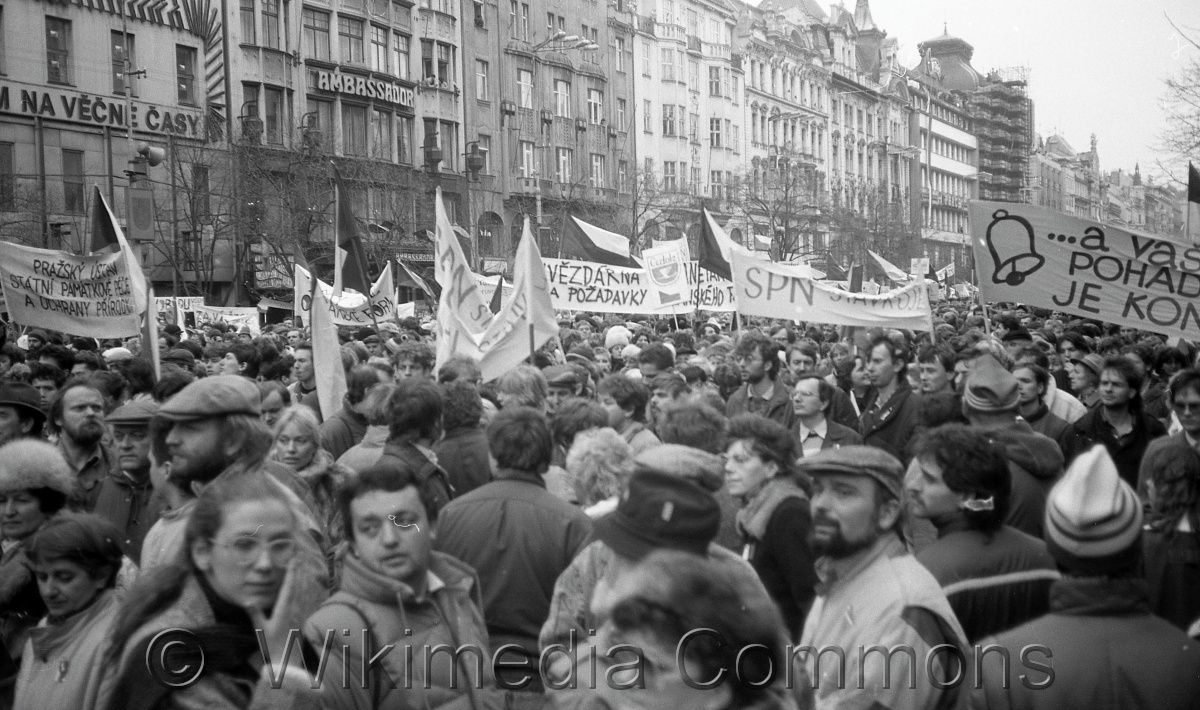
Velvet Revolution, 1 December 1989. Wikimedia Commons. Accessible here.
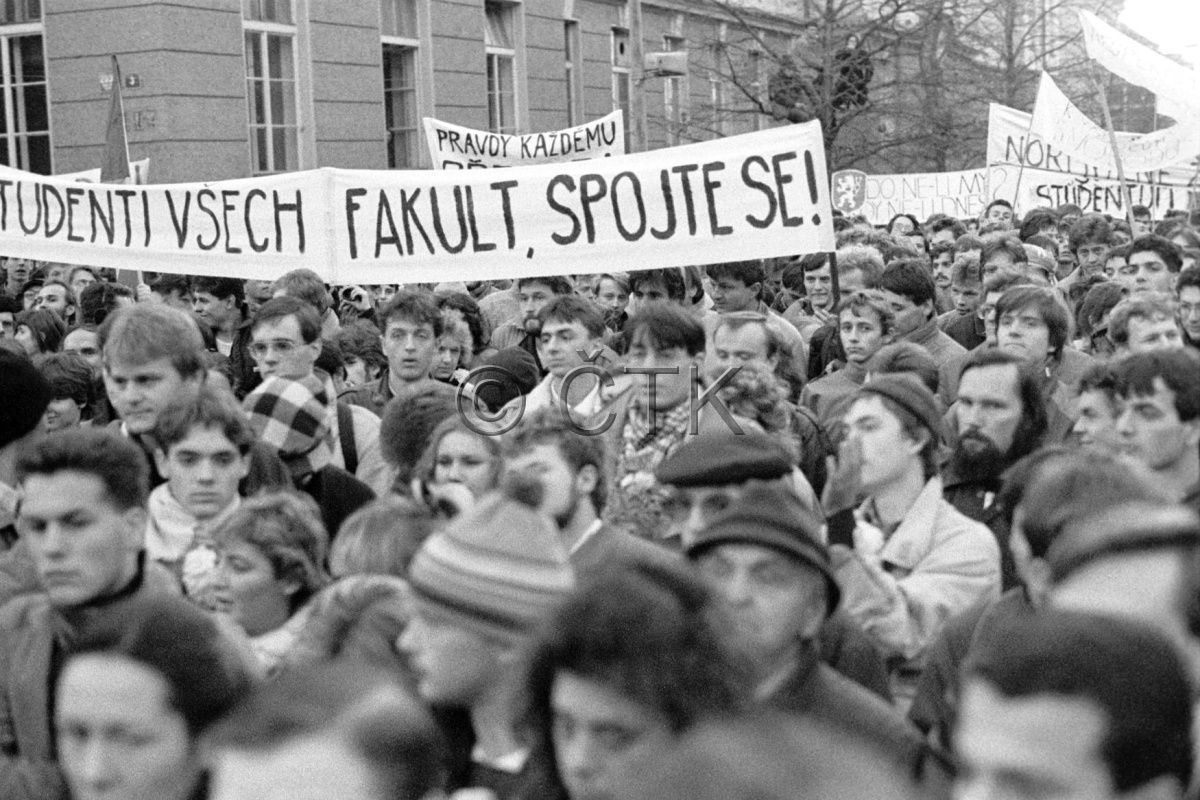
Student demonstration in Prague at Albertov on November 17, 1989. ČTK / Hroch Pavel.
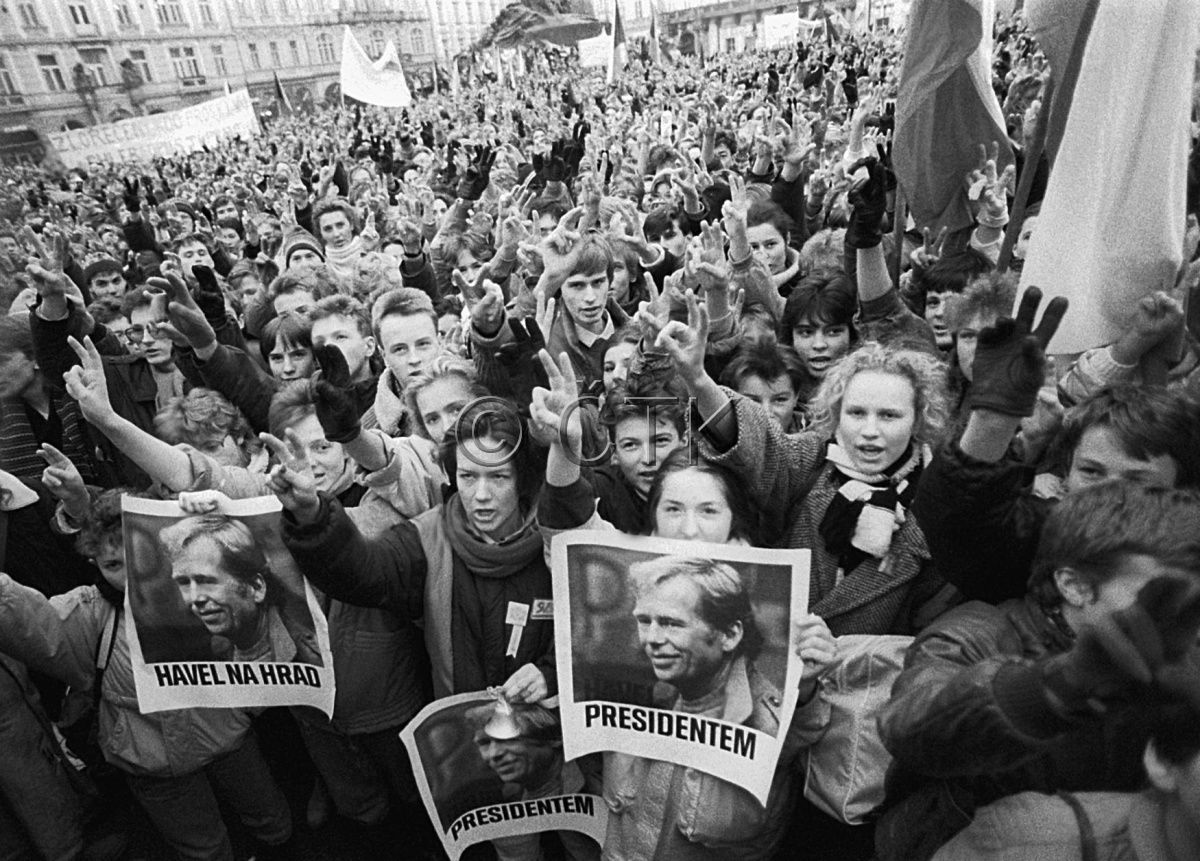
Demonstration on the Old Town Square on December 11, 1989. ČTK / Hroch Pavel.
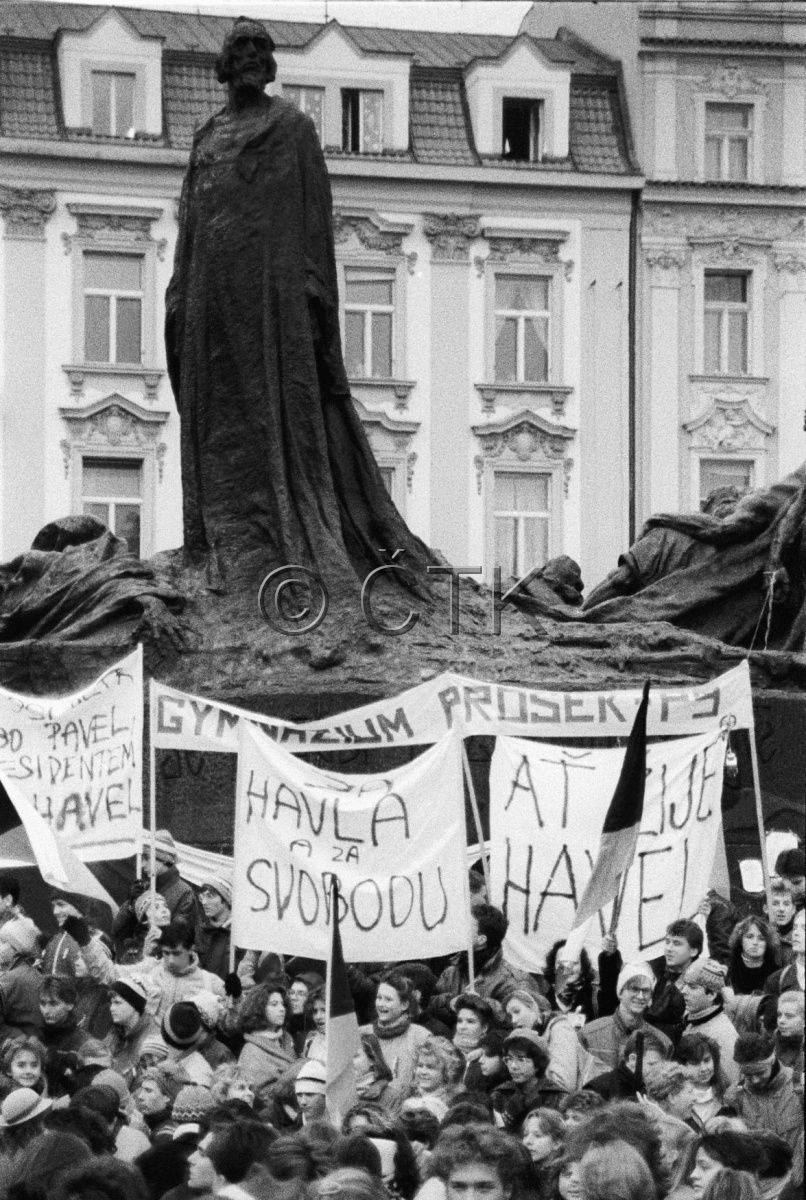
Demonstration on the Old Town Square on December 11, 1989. ČTK / Hroch Pavel.
References
Sedm pražských dnů 21.‒27. srpen 1968. Praha 1968, 1990;
Otáhal, M. ‒ Sládek, Z.: Deset pražských dnů. Praha 1990;
Dejmek, J. a kol.: Československo. Dějiny státu. Praha 2018;
Semotanová, E. Zudová-Lešková, Z. ‒ Močičková, J. Cajthaml, J. ‒ Seemann, P. ‒ Bláha J. D. a kol.: Český historický atlas. Kapitoly z dějin 20. století. Praha 2019;
Server TOTALITA.cz, dostupné z http://www.totalita.cz/ost/totalita_os.php, [ověřeno 28. 3. 2019].

This work is licensed under a Creative Commons BY-NC-ND 4.0
Beginning of Resistance against the Communist Regime and the Velvet Revolution (Czechoslovakia)
In the second half of the 1960s, the resistance against the regime was growing, especially in politics, economy, culture and civil life. The revivalistic process in the society was violently broken by the Soviet Union, which regarded it as a counter-revolution and attack against socialism and communism. On 21 August 1968, the armies of the Soviet Union, the German Democratic Republic, Poland, Hungary, and Bulgaria invaded Czechoslovakia, thus terminating all efforts to democratise society. The Soviet units were deployed in the country to protect the socialist establishment and remained there until 1991. These events prompted mass cleansing in various areas of society and started the process of normalisation to preserve the communist regime. There were many protests against the occupation. The unforgettable moments that still remind us of the tragic events include the so-called “Human Torches”. Ryszard Siwiec, Jan Palach, Jan Zajíc, Josef Hlavatý, and Evžen Plocek burned themselves to death in protest against the occupation, scarifying their lives to the ideas of democracy and freedom.
Opponents of the ruling regime gradually emerged. In 1977, they issued a statement called “Charter 77”, in which they demanded changes in the society in favour of democracy and respect for human rights. However, they faced severe repressions. The resistance against the regime culminated on 17 November 1989 with a student demonstration in Prague terminated by police intervention in Národní třída. The peaceful student manifestation was severely suppressed by the police forces and became a catalyst for the “Velvet Revolution” when the existing political and social structures rapidly collapsed within several days. The political movement Občanské hnutí [Civic Forum] was established in the Činoherní klub theatre in Prague, uniting not only groups of dissidents but all citizens who disapproved of the existing regime. Václav Havel became the leading figure and in Slovakia, where a similar civic movement Verejnosť proti násiliu [Public against Violence] was established, Ján Budaj and Milan Kňažko became the leaders. The communist regime fell and the process of returning Czechoslovakia to the democratic European states began. The Czechoslovak political system, but also the economy and the entire structure of the society started to transform in the spirit of liberal principles. The new values, self-realization, free will, but also the emerging negative aspects of the development affected the behaviour and thinking of many groups of the population. On 1 January 1993, three years of democratic Czechoslovakia were terminated by its separation into two sovereign equal states, the Czech Republic and the Slovak Republic.

Velvet Revolution, 1 December 1989. Wikimedia Commons. Accessible here.
References
Sedm pražských dnů 21.‒27. srpen 1968. Praha 1968, 1990;
Otáhal, M. ‒ Sládek, Z.: Deset pražských dnů. Praha 1990;
Dejmek, J. a kol.: Československo. Dějiny státu. Praha 2018;
Semotanová, E. Zudová-Lešková, Z. ‒ Močičková, J. Cajthaml, J. ‒ Seemann, P. ‒ Bláha J. D. a kol.: Český historický atlas. Kapitoly z dějin 20. století. Praha 2019;
Server TOTALITA.cz, dostupné z http://www.totalita.cz/ost/totalita_os.php, [ověřeno 28. 3. 2019].

This work is licensed under a Creative Commons BY-NC-ND 4.0

